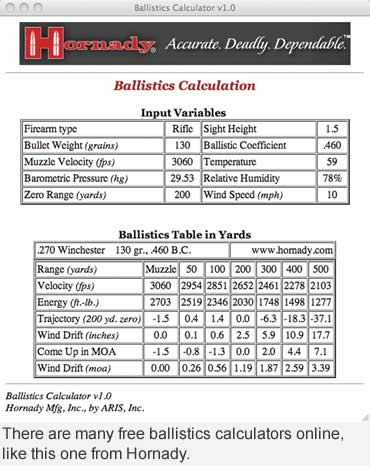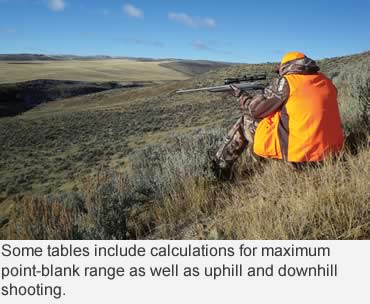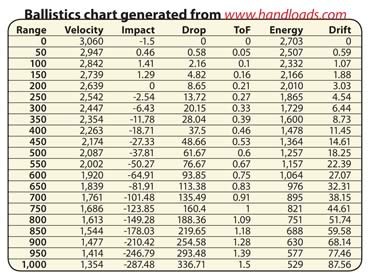All those columns, numbers and abbreviations become clear as you explore.
The majority of hunters are not ballistics experts. Nor do they have to be. Some of the most successful hunters know nothing more about rifles than which cartridge to shoot through it, usually to deadly effect.
Many of us, however, become curious, sometimes fascinated by ballistics. We are no longer satisfied to know we must buy .270 Winchester, not .270 Weatherby, ammo to work in our rifle. We want to know why we should use Federal’s 110-grain Barnes Tipped Triple Shock instead of Winchester’s 130-grain Ballistic Silvertip instead of Remington’s 130-grain AccuTip Boat Tail or Hornady’s 130-grain Spire Point Interlock.
So we start investigating and quickly discover ballistics charts, which can be confusing.
All of those columns, numbers and abbreviations can make your head spin. It’s like reading a map of Russia with place names in the Cyrillic alphabet.
Fear not, intrepid shooter. All will become clear as you explore.
A ballistic chart or table can appear as a graphic depiction of the bullet’s flight or as a table of columns listing a number of parameters. We’ll cover numbered tables and charts in this space.
 At left is a chart from Hornady’s online Ballistic Calculator. Most input variables are self-explanatory.
At left is a chart from Hornady’s online Ballistic Calculator. Most input variables are self-explanatory.
Temperature, Barometric Pressure and Relative Humidity are included because both change a bullet’s flight path by changing air density, which increases or decreases drag on the bullet.
Wind Speed is assumed on this and other ballistics charts as coming from a right angle to the line of departure of the bullet.
The Velocity line reflects the speed of the bullet at each downrange distance shown. Energy lists kinetic energy remaining in the bullet at each distance. Trajectory shows where the bullet should strike at the various ranges.
Note the -1.5 inches at the muzzle. This reflects the average distance of the scope reticle above the bore. With some large-objective scopes, this could be -1.75 or -2 inches. Persnickety shooters measure this distance and enter it into the variables because it makes a slight difference in downrange trajectory (maybe an inch at 500 yards.)
The Wind Drift line shows how far the bullet will be deflected by that 10-mph right-angle wind, assuming it is constant and consistent. The wind direction of flow, left or right, doesn’t matter. It is assumed the shooter will be smart enough to understand wind from the left will deflect the bullet to the right and vice versa.
 Similarly, the shooter is supposed to understand how to modify these deflections in quartering winds. Note that Wind Drift is given in inches and MOA. If this confuses you, welcome to the club.
Similarly, the shooter is supposed to understand how to modify these deflections in quartering winds. Note that Wind Drift is given in inches and MOA. If this confuses you, welcome to the club.
When I was starting out, it confused me, too, because I was taught that MOA, minute of angle, meant 1 inch at 100 yards. What I didn’t get right away was that MOA is a measure of angle, a degree of angle, and at a distance, angles spread. Thus, the 1.047-inch MOA at 100 yards becomes a 2.094-inch spread at 200 yards, 3.141-inch at 300 yards, etc. So the 2.5 inches of wind deflection at 200 yards is only 1.19 MOA because 1 MOA at 200 yards is already 2.094 inches.
MOA numbers are quite useful for shooters who use MOA dots or sub-reticles on their crosshairs for holding into the wind. A spotter’s command of “Give me 3 MOA wind” is easier for the shooter to measure and put into effect than “Give me about 12 inches of wind” at 450 yards.
Come Up in MOA works similarly. Instead of guessing a 37.1-inch hold over a target at 500 yards, you hold the 7 MOA dot of your reticle right on target.
All of this computer-generated data assumes you are shooting a bullet with a BC of .460 at a precise 3,060 fps. You might not be. Muzzle velocities of any given load vary slightly, sometimes as much as 200 fps.
And every rifle changes the BC of a bullet, sometimes significantly. So wise shooters use ballistics charts as a starting point and check them against real-world performance at a range. Extensively. Does your bullet really and consistently drop what the table predicts at 500 yards?
 In lieu of a computer program, you can find ballistics tables in manufacturer catalogs and handloading manuals. Neither these nor all computer programs are the same, but they should all yield the same numbers if their math and algorithms are correct. A few aren’t, so it’s good to check them against one another.
In lieu of a computer program, you can find ballistics tables in manufacturer catalogs and handloading manuals. Neither these nor all computer programs are the same, but they should all yield the same numbers if their math and algorithms are correct. A few aren’t, so it’s good to check them against one another.
Not shown is the information entered about bullet BC, muzzle velocity, etc, the same as entered in the Hornady program. This time, I requested calculations out to 1,000 yards, which I could have done with the Hornady program. This program, like many, lets you choose data for every 100 yards, 50 yards, 25 yards, even 10 yards.
Notice this table has no MOA data but adds a ToF (time of flight) column. Interesting to see how quickly a bullet gets downrange and the relationship between time of flight and wind deflection, called Drift here. But why is there an Impact column and Drop column?
Impact shows where the bullet hits based on the sight-in range. Drop is the pure amount of drop of the bullet if it is fired from a perfectly level barrel. In real world shooting barrels are tilted slightly upward in relation to the line-of-sight. Not all charts treat drop this way, some meaning actual bullet impact.
Some tables include calculations for angled shooting, listing impact points if you’re shooting at, say, a 30-degree angle uphill. Some will add a column showing TKO or Momentum values, other ways of rating impact energy or effectiveness on game.
Some, like those in the old “50th Anniversary Sierra Rifle Reloading Manual” (4th Edition) include a column for Maximum Point-Blank Range, quite useful for hunters using that method for determining dead-on holds. You’ll find these Sierra tables at exteriorballistics.com.
Search the Internet for ballistics calculators, and you’ll find many you can buy, or download free or use online. As you do use them, you’ll be inspired to learn more and shoot even better.
Read Recent GunHunter Articles:
• The .30-06 Cartridge Family: Offspring of the .30-06 are popular and effective, just like their Ma.
• Marlin’s XT Youth .22s: The XT series of rimfire rifles are budget models with kid-worthy features.
This article first appeared in the August 2011 issue of Buckmasters GunHunter Magazine. Subscribe today to have GunHunter delivered to your home.